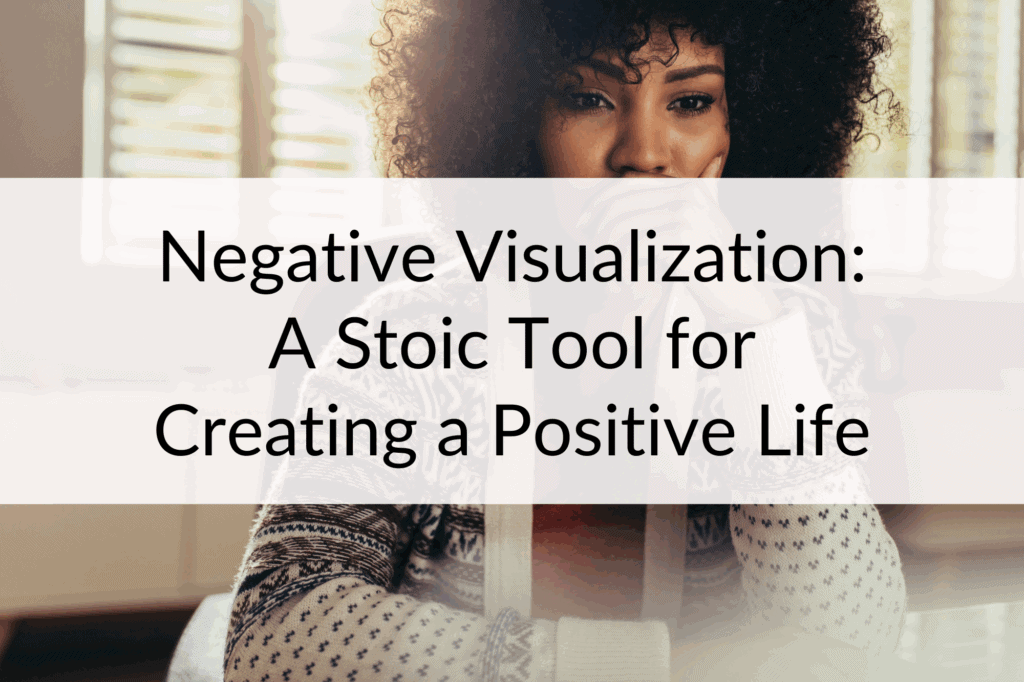Negative visualization might sound like an odd, even counterproductive, practice. Our culture often suggests we should focus only on positive outcomes and success. But what if one of the most powerful tools for happiness comes from briefly considering loss?
This ancient technique, practiced by the Stoics, can be a potent method for personal growth and finding a deeper appreciation for your life. Let’s explore how the negative visualization technique works and why this ancient art is surprising relevant today.
Table Of Contents:
- What Is Negative Visualization?
- The Stoic Roots of Premeditatio Malorum
- The Benefits of Negative Visualization
- How to Practice Negative Visualization
- Common Misconceptions About the Practice
- Real-Life Applications of Negative Visualization
- Negative Visualization Brings Positive Change
What Is Negative Visualization?
Negative visualization is a cognitive exercise where you consciously take time imagining losing the things you value most. This could include your relationships, your health, your possessions, or your job.
However, the practice isn’t about morbidly dwelling on worst-case scenarios. Instead, it’s about briefly and calmly contemplating what your life would be like without these essential parts.
The ancient Stoics, including figures like the great Stoic philosopher Seneca, called this practice ‘premeditatio malorum,’ which translates to the ‘premeditation of evils.’ They believed it could psychologically prepare people for the inevitable difficulties life throws their way. It helps you appreciate what you have right now and builds a buffer against future misfortunes.
This stoic philosophy encourages us to see that the things we possess are all temporary, and that anything can be taken away. By contemplating this reality, we can reduce our attachment to external things and find a more stable form of contentment, often called stoic joy.

The Stoic Roots of Premeditatio Malorum
To fully grasp negative visualization, it helps to understand its origins with the great Stoic philosophers. Figures like the Roman emperor Marcus Aurelius, the playwright and advisor Seneca, and the former slave Epictetus all wrote about preparing the mind for adversity. They didn’t see this as pessimism. Rather, as a practical and rational approach to a good life.
The Stoics understood that much of human suffering comes not from events themselves, but from our reactions to them. By mentally rehearsing potential negative outcomes, you can soften the blow if they actually happen. This practice was central to their goal of living in accordance with nature and maintaining inner peace regardless of external circumstances.
Modern authors like Ryan Holiday and William Irvine have been instrumental in reintroducing these ancient stoic exercises to a new generation. They explain how a concept developed thousands of years ago is backed by aspects of modern science and positive psychology.
This is a comparison of perspectives from key Stoic philosophers on premeditatio malorum.
| Stoic Philosopher | Core Idea | Key Quote/Concept |
|---|---|---|
| Seneca | Emphasized using premeditatio malorum to rehearse for hardship and reduce the shock of loss. The philosopher Seneca believed that what is rehearsed in the mind strikes with less force. | “What is quite unlooked for is more crushing in its effect, and unexpectedness adds to the weight of a disaster.” |
| Epictetus | Focused on reminding oneself of the impermanent nature of all things, from a favorite cup to a loved one. This helps in detaching from outcomes beyond our control. | “When you are delighted with anything…remind yourself that it is not one of the things that cannot be taken away.” |
| Marcus Aurelius | His writings in ‘Meditations’ often show him mentally preparing for the day ahead, anticipating difficult people and frustrating events to maintain his composure and act with virtue. | “Begin each day by telling yourself: Today I shall be meeting with interference, ingratitude, insolence, disloyalty, ill-will, and selfishness.” |
The Benefits of Negative Visualization
You might still wonder why anyone would voluntarily spend time imagining negative events. However, when you practice negative visualisation correctly, it can yield significant psychological benefits. Modern research aligns with the wisdom of the ancient Stoics on this.
1. Increased Gratitude
When you consistently imagine life without the people, abilities, and possessions you care about, you cultivate gratitude on a profound level. This stoic exercise serves as a powerful antidote to the trap of taking things for granted. Suddenly, a normal day with your family or your ability to go for a walk becomes a gift.
For example, take a moment to imagine losing your sense of taste. How would your favorite meal seem? After this thought experiment, you’d feel a renewed appreciation for the simple pleasure of eating.
People who have practiced negative visualization report a significant increase in their daily feelings of thankfulness.
2. Reduced Anxiety and Fear
By mentally preparing for potential setbacks, you can significantly reduce fear and anxiety about the future. It works much like exposure therapy, where controlled contact with a feared stimulus diminishes its power.
Think about the common fear of public speaking. If you visualize stumbling over your words or forgetting your lines, you can then plan your response. This process helps reduce the fear because the “what if” is no longer an unknown monster — it’s a problem with a potential solution.
3. Improved Resilience
Negative visualization also helps you build mental toughness and emotional resilience. By regularly imagining how you would cope with difficult situations, you are effectively training your mind to handle real challenges. When life happens and adversity strikes, you won’t be caught completely off guard.
For example, if you’ve spent time considering how you’d manage after a job loss, you might be more proactive about saving money or learning new skills. This mental preparation means you are better equipped to weather life’s storms, and is a core reason the stoic philosophers valued this practice.
4. Clarification of Values
Imagining the loss of various parts of your life helps clarify what is truly important to you. When you picture life without your career, your car, or your social status, you might find that the emotional impact is less than you’d expect. In contrast, imagining life without a close friend or family member often reveals the deep value of that relationship.
This process helps you align your daily actions with your core values. It guides you to invest your time and energy in the people and activities that bring genuine meaning.
How to Practice Negative Visualization
Are you ready to try this powerful visualization technique? The process is simple, but its impact can be profound. Here are some steps to get you started on your journey.
-
Choose a Focus. Pick something or someone you value. It could be a close relationship, your physical health, your current job, or even a simple daily comfort like your morning coffee.
-
Imagine Its Absence. Set aside a few quiet minutes. Close your eyes and vividly imagine your life without that specific person or thing. What would your daily routine look like, and how would you feel?
-
Acknowledge Your Feelings. As you do this, pay attention to the emotions that arise. You might feel a sense of sadness, anxiety, or loss. The goal is to observe these feelings without judgment, not to get lost in them.
-
Return to the Present and Reflect. After a few moments, bring your focus back to the present moment. Acknowledge that you still have this wonderful thing in your life. Notice the feeling of relief and gratitude that follows.
-
Use a Stoic Journal. Consider writing about your experience in a stoic journal. Documenting your thoughts can deepen the practice and help you track how your perspective shifts over time.
-
Practice Regularly. Like any skill, negative visualization works best with consistent practice. Try this exercise for a few minutes each day or a few times a week, focusing on different aspects of your life to cultivate gratitude broadly.

Common Misconceptions About the Practice
Some people are hesitant to practice negative visualization, fearing it will make them pessimistic or anxious. When performed correctly, it should produce the opposite effect. Let’s address some common misunderstandings.
1. It’s Not About Constant Worrying
A key distinction is that negative visualization is a deliberate, short, and controlled exercise. It is not the same as chronic worrying or ruminating on all the things that could go wrong.
The goal is a brief mental visit to a potential reality, followed by a grateful return to the present, not a permanent residence in anxiety.
2. It Complements Positive Thinking
This practice is not meant to replace positive thinking or goal setting. The two can work together beautifully. You can visualize achieving your goals and succeeding, while also using negative visualization to appreciate your current progress and prepare for potential obstacles along the way.
3. It’s Not Expecting the Worst to Happen
The objective is not to become a doomsayer who expects bad things to happen at every turn. Rather, it is about acknowledging that hardship is a part of life and appreciating what you have right now.
It helps you mentally prepare and build resilience, not to live in a state of dread.
4. It Is Not for Everyone in Every Situation
For most people, this practice is a healthy tool for improving mental health. However, for individuals with severe anxiety, depression, or a history of trauma, including eating disorders, focusing on negative outcomes could be triggering.
If you find the practice increases your anxiety, it’s best to stop and consult a professional about alternative methods like mindfulness or therapy.
Real-Life Applications of Negative Visualization
The principles of this Stoic exercise can be applied to almost any area of your life to foster appreciation and preparedness. Once you have practiced negative, you will see its benefits in many different areas.
1. In Relationships
Regularly imagine life without your partner, a close friend, or a family member. Think about the conversations you’d miss or the support that would be gone. This thought process can motivate you to be more present, patient, and loving in your interactions today and helps reduce fear of abandonment.
2. At Work or in Your Career
Consider what it would be like to lose your job or for your business to fail. You’d feel the initial panic, but then what? This exercise might inspire you to build your savings, update your skills, or strengthen your professional network — making you more adaptable to career changes.
3. With Your Physical Health
Imagine being unable to walk, run, or engage in your favorite physical activities. Contemplate a day with chronic pain. This visualization can motivate you to appreciate your current abilities and inspire you to take better care of your body through diet and exercise.
4. For Personal Growth and Goals
Picture yourself failing to achieve a significant personal goal. It’s a humbling thought, but it can help you identify potential roadblocks and weaknesses in your plan. This allows you to create a more robust strategy and mentally prepare for the effort required, knowing that the journey is as important as the destination.
Negative Visualization Brings Positive Change
Negative visualization may seem like a strange path to happiness, but this ancient Stoic practice is a powerful tool for a more joyful and resilient life. By briefly and consciously taking time imagining life without the things you cherish, you deepen your gratitude for what you have right now.
The wisdom of the Stoic philosophers teaches us that preparing for adversity doesn’t mean living in fear — it means building the psychological strength to face whatever comes.
So give this ancient art a try. You may be surprised how this “negative” visualization technique can introduce a wealth of positivity, contentment, and strength into your life.



